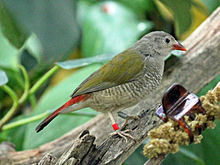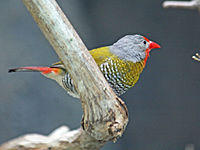| Green-winged pytilia | |
|---|---|

| |
| Adult male, Tsavo East NP, Kenya | |

| |
| Female, San Diego Zoo | |
| Conservation status | |
 Least Concern (IUCN 3.1) | |
| Scientific classification | |
| Domain: | Eukaryota |
| Kingdom: | Animalia |
| Phylum: | Chordata |
| Class: | Aves |
| Order: | Passeriformes |
| Family: | Estrildidae |
| Genus: | Pytilia |
| Species: | P. melba |
| Binomial name | |
| Pytilia melba (Linnaeus, 1758) | |
| Synonyms | |
|
Fringilla melba Linnaeus, 1758 | |
The green-winged pytilia (Pytilia melba) is a small colourful seed-eating bird in the family Estrildidae. It is widespread throughout Sub-Saharan Africa, though it is more rarely seen in central, far southern and coastal western parts of the continent.
Taxonomy
The green-winged pytilia was formally described in 1758 by the Swedish naturalist Carl Linnaeus in the tenth edition of his Systema Naturae under the binomial name Fringilla melba. No explanation was provided for the specific epithet melba but it could possibly be from a supposed Chinese word or place. Linnaeus based his description on "The Green Gold-Finch" that had been described and illustrated in 1750 by the English naturalist George Edwards in his A Natural History of Uncommon Birds. Edwards was uncertain of the origin of his specimen and Linnaeus mistakenly specified the locality as China. The specimen was subsequently assumed to be from Angola, but this was restricted to Luanda in Angola by Phillip Clancey in 1962. The green-winged pytilia is now placed in the genus Pytilia that was introduced in 1837 by the English naturalist William Swainson for the red-winged pytilia.
Eight subspecies are recognised:
- P. m. citerior Strickland, 1853 – Mauritania, Senegal and Gambia to south Sudan
- P. m. jessei Shelley, 1903 – northeast Sudan to northwest Somalia
- P. m. soudanensis (Sharpe, 1890) – southeast Sudan, south Ethiopia, central, south Somalia, northeast Uganda and north, east Kenya
- P. m. percivali Van Someren, 1919 – central Kenya to north Tanzania
- P. m. belli Ogilvie-Grant, 1907 – east DR Congo and west Uganda to west Tanzania
- P. m. grotei Reichenow, 1919 – east Tanzania, north Mozambique and east Malawi
- P. m. hygrophila Irwin & Benson, 1967 – north Zambia and north Malawi
- P. m. melba (Linnaeus, 1758) – south Congo and Angola to southwest Tanzania and south to central Namibia, north South Africa and south Mozambique
Gallery
-
 Male, San Diego Zoo
Male, San Diego Zoo
-
 Male, Serengeti, Tanzania
Male, Serengeti, Tanzania
References
- BirdLife International (2017). "Pytilia melba". IUCN Red List of Threatened Species. 2017: e.T22719344A111722703. doi:10.2305/IUCN.UK.2017-1.RLTS.T22719344A111722703.en. Retrieved 11 November 2021.
- Linnaeus, Carl (1758). Systema Naturae per regna tria naturae, secundum classes, ordines, genera, species, cum characteribus, differentiis, synonymis, locis (in Latin). Vol. 1 (10th ed.). Holmiae (Stockholm): Laurentii Salvii. p. 180.
- Jobling, James A. (2010). The Helm Dictionary of Scientific Bird Names. London: Christopher Helm. p. 248. ISBN 978-1-4081-2501-4.
- Edwards, George (1751). A Natural History of Uncommon Birds. Vol. Part III. London: Printed for the author at the College of Physicians. p. 128, Plate 128.
- Zedlitz, O. Graf (1916). "Das Süd-Somaliland als zoogeographisches Gebiet". Journal für Ornithologie (in German). 64 (1): 1–120 . Bibcode:1916JOrni..64....1Z. doi:10.1007/BF02250363. S2CID 36424707.
- Clancey, Phillip Alexander (1962). "On the validity of Pytilia melba damarensis Neunzig, 1928". Bulletin of the British Ornithologists' Club. 82: 3–5 .
- Swainson, William (1837). The Natural History of the Birds of Western Africa. Vol. 1. Edinburgh: W.H. Lizars. p. 203.
- ^ Gill, Frank; Donsker, David; Rasmussen, Pamela, eds. (July 2021). "Waxbills, parrotfinches, munias, whydahs, Olive Warbler, accentors, pipits". IOC World Bird List Version 11.2. International Ornithologists' Union. Retrieved 15 July 2021.
External links
- Species text in The Atlas of Southern African Birds
- Green-winged Pytilia (Melba Finch) Species Profile
This Estrildidae-related article is a stub. You can help Misplaced Pages by expanding it. |